CLARITY
All diamonds have identifying characteristics, but most are invisible to the naked eye. To view a diamond, experts use a 10x magnifying loupe which allows them to see the appearance of tiny crystals, feathers or clouds. These natural phenomena are called inclusions. There are five categories in class that anyone interested in purchasing a diamond should be aware of when grading clarity.
Diamond Clarity Scale

FL (Flawless) – IF (Internally Flawless)
Flawless Diamonds reveal no flaws on the surface or internally are the rarest and most beautiful gems.Internally Flawless Diamonds reveal no inclusions and only insignificant blemishes on the surface under 10x magnification.
VVS1 – VVS2 (Very, Very Slightly Included)
Very difficult to see inclusions under 10x magnification. These are excellent quality diamonds.
VS1 – VS2 (Very Slightly Included)
Only looking through a 10X loupe can pinpoint the inclusions in this category and are nearly impossible to see with the naked eye. These are less expensive than the VVS1 or VVS2 grades.
SI1 – SI3 (Slightly Included)
Diamonds with inclusions easily identified under 10x magnification. Finding flaws in this category with the naked eye is difficult. The gems in this category maintain their integrity, depending on the location of the inclusions.
I1 – I3 (Included)
Diamonds with inclusions which may or may not be easily seen by the naked eye. The flaws on the stones in this category will have some effect on the brilliance of your diamond.
COLOR
Many experts name colour as the number one consideration in choosing a diamond. A diamond’s colour is graded on an alphabetical scale from D-Z, with D being absolutely colourless and Z being light yellow. Beyond “Z”, a diamond is considered to be an exotic or “Fancy” colour
Diamond Colour Scale

Since colour differences can be so subtle, they are impossible to determine by the untrained eye. To grade a diamond, gemmologists often place it on a white background next to another diamond that has been previously graded.
If all other factors are equal, the less colour in a diamond or the higher colour rating, the more valuable a diamond becomes. Likewise, as the amount of colour increases, the price of a diamond decreases although this does not necessarily reduce the beauty of a diamond.
CARAT
This diagram is for presentation purposes and is not to scale

Carat is often confused with size even though it is a measure of weight. The cut of a diamond can make it appear larger or smaller than its actual weight.
One carat is the equivalent of 200 milligrams. One carat can be divided into 100 “points”. A .75 carat diamond is the same as 75 points or a 3/4 carat diamond. Since larger diamonds are rarer than smaller diamonds, the value rises exponentially with carat weight.
CUT
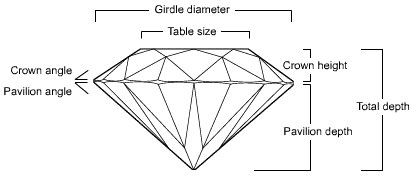
Cut actually refers to two aspects of a diamond. The first is its shape (round, marquise, etc) the second is how well the cutting has been executed.
A diamond’s cut will most certainly influence its fire (the lovely rainbow colours that flash from within) and brilliance (the liveliness and sparkle), as well as its perceived size and even, to some degree its apparent colour. Different cuts reflect light in different angles. A diamond must be cut in a geometrically precise manner to maximize its brilliance.
SHAPE
Shape refers to the overall outline of the diamond when viewed from the top.
Round Brilliant
The Round Brilliant-cut Diamond is polished to fifty-eight facets giving maximum shine and brilliance. The round Brilliant-cut is the most traditional and popular for a solitaire engagement ring.
Pear
A shining teardrop, lovely when used either side of a central stone.
Emerald
A traditional shape, with old world elegance.
Heart
The ultimate romantic symbol, very sentimental shape.
Asscher
A very unique look, developed by world renowned Diamond cutter Joseph Asscher. This Diamond has eight sides.
Marquise
A traditional Shape which seems to elongate the fingers.
Radiant
With cut in corners similar to an emerald cut.
Oval
A cut designed 200 years ago, a popular choice for three stone anniversary rings with two matching Diamonds each side.
Cushion
This unique shape has been popular for more than a century. Cushion-cut diamonds (also known as ‘pillow-cut’ diamonds) have rounded corners and larger facets to increase their brilliance.
DIAMOND SETTINGS
The way the stones are held in the setting is an integral part of its design. Each setting technique creates a look that is part of the overall style of the ring. You may like one ring rather than another simply because of the setting technique used.
Prong Setting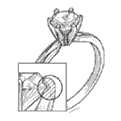
The most common and popular type of setting, with either 4 or 6 prongs. The high position of the diamond allows maximum exposure to the light from top to bottom. This type of setting can be used for all kinds of faceted stones.
Bezel Setting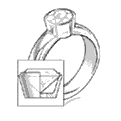
The bezel setting had been used for hundreds of years. The diamond is set deep inside of the mounting, then, using a burnishing tool, the outer metal mass is pushed over the edges of the stone to create a strip which holds it in place. This setting can be used for any type of stone.
Pave Setting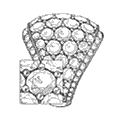
The stones are placed side by side in small openings on a flat surface. The diamonds are secured by raised overlapping gem spurs and are finished by creating beads.
V-Prong Setting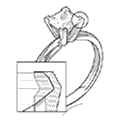
The diamond fits snugly inside notches carved on both sides of a prong. Two sides of a prong are squeezed from both sides to hold the stone in place and to protect from accidental breakage. A popular setting type for princess cut diamond rings.
Channel Setting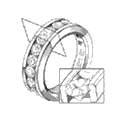
Channel settings can be used for a variety of faceted stones – round brilliant, princess cut, emerald cut, baguettes, etc. the stones are aligned girdle-to-girdle along the groove and secured by hammering the upper sides of the channel walls.

